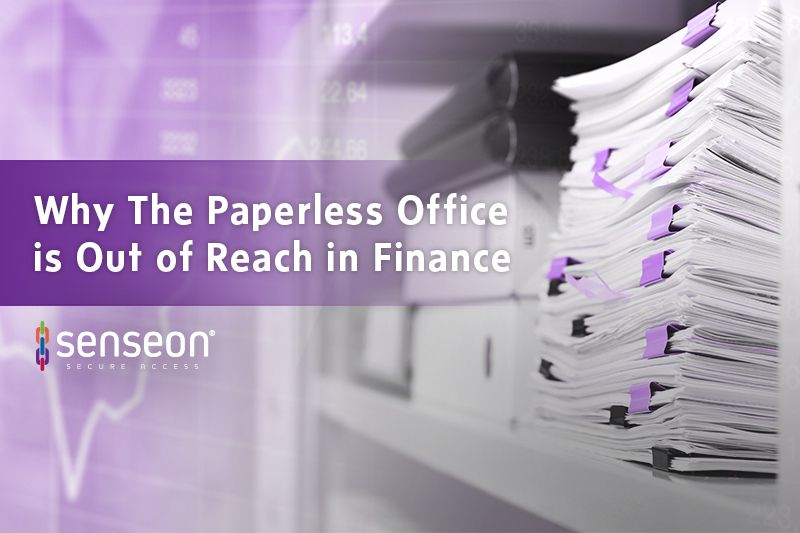The reality of a paperless office is more attainable with new technologies and the increased access to cloud storage. While there are more resources, which can reduce the need for paper in business operations, only 24% of financial firms have policies in place to lower paper consumption and those that do, only reduce the amount of paper used by an average of 5%.
Here are 5 key reasons financial service companies struggle to achieve a paperless office:
1. Customers Demand Paper
Financial offices are heavy users of paper. Processes involving paper can include account opening policies, ongoing communications, mandatory compliance notifications, tax forms, trade documentation, and so forth. While many companies try to entice customers to receive communications electronically, many prefer paper statements, receipts, and notifications.
Consumers are creatures of habit. When completing a financial transaction, they want a paper receipt detailing the activity, warranties, and obligations. It is difficult for a customer to consume and understand multiple pages of the legal fine print on a tablet. Paper copy allows them to read and better understand the terms without having to print the forms at home.
Financial products often have many moving parts with detailed terms of the agreement and rules to follow. For instance, a homeowner’s insurance policy might include dozens of exclusions, and a bank account typically has a long list of rules a customer must follow to avoid fees. Most customers want these details in a paper format rather than through email or other electronic means.
Even in the digital age, 54% of consumers choose to receive paper statements. The primary reasons for loyalty to the paper processes include habit, ease of reviewing the charges and activity, and the increased likelihood of reviewing a paper statement versus an online statement.
2. Employee Use of Paper
In addition to customers’ preference for paper, employees have habits in place that utilize paper. For instance, an employee might print or copy customer documents before entering the information into the computer, print a customer profile before a meeting, or create a physical file for future reference. Employees also print out notes, presentations, and forms, making it more difficult for companies to achieve a paperless office.
Even after integrating paperless solutions such as software to streamline the account opening process, companies find that if both clients and staff do not change their behavior paper use does not decline.
3. Legislation and Compliance
Government departments regulate the financial services industry, which controls everything from customer fees to required communication and disclosures. The E-Sign or Electronic Signature Act, signed into law on June 30, 2000, expanded the ability of financial service companies to use e-signatures in many applications opening the door for more paperless processes. However, companies must still meet compliance standards which dictate what a business my store for how long and in what format. Not all transactions allow e-signatures and electronic means of document storage.
Here are three main reasons financial service companies maintain physical files
- Ensure Compliance. Companies must maintain records from three months to 30 years, depending on the transaction.
- Retain Evidence. Litigation is a major concern for financial service companies. Whether it is the collection of past debt or stock market transactions, businesses must maintain records, which include not only the details of the transaction, but client approvals, suitability, and other proof of regulatory compliance.
- Operations. Documentation of company policies, procedures, and other operational details can serve as evidence and reduce or eliminate criminal fines, civil liability, and harm of their reputation. In some cases, storing physical evidence and physical files is a necessary part of operations.
4. Online Security Vulnerabilities
The increased use of cloud storage has opened the door for more use of software and online storage technologies. However, along with the convenience of having everything online, comes with the risk of having everything online. Each year, more hackers target financial firms. Malware, ransomware, and data security breaches threaten the safety and security of online data.
Companies combat this threat with the use of frequent file backups, storing online data in multiple locations, and physical file storage to protect against online security vulnerabilities
5. The Sharing of Data and Information
New technologies and laws have increased electronic data sharing, making it easier for firms to convert processes into electronic formats. These operational procedures can include customer onboarding, storing and transferring data, meeting compliance requirements, and so forth.
Each touchpoint might also involve customers and employees. A staff member might manually write down customer information as they open an account. The customer may request copies of the transaction, receipts, or other documents. Records and files containing sensitive customer data for everything from making trades, buying insurance, or applying for a loan. Even if the company has electronic means to store data, customers and employees often print and store sensitive information.
Security Solutions for Confidential Paper Files and Company Assets
Regulators hold financial firms to a higher standard when it comes to both physical and online security. The industry faces more attention from hackers, making the financial industry one of the top industries to experiences data hacks or security breaches, second only the health care for the highest total losses each year.
From a physical security standpoint, banks have seen an uptick in bank robberies, according to the American Banker, requiring banks and financial service firms to step up physical security measures. In addition to external theft, financial services also experience high levels of internal theft. In 2017, businesses lost over 50 million due to employee or internal losses, with financial services experiencing the highest amount, totaling over $120 million, according to a CNBC report.
To protect against losses from both internal and external sources, corporations can employ new technologies such as Senseon Plus. This cabinet-level access control system tracks entry to secure cabinets and comes equipped with advanced security features, such as dual authorization, which employs the four eyes principle for improved checks and balances.
Physical security does not get the attention of cybersecurity but, with additional security measures, can play a major role in reducing costs within an office or warehouse environment.
For more on Senseon’s intelligent cabinet-level access control systems, Click the button below!






